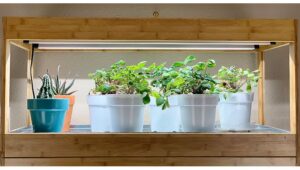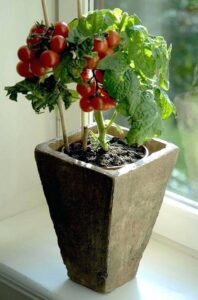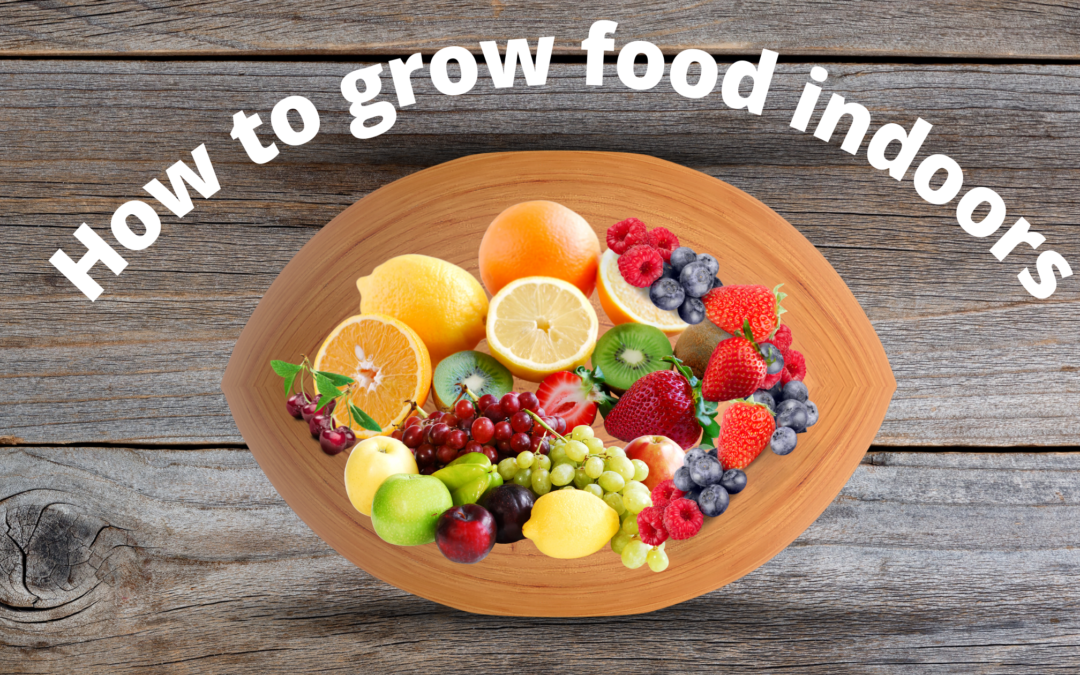Written by: Jeffrey Zhang
Have you ever wanted to try growing food indoors, saving trips to the grocery store? Have you decided that going outside is a risk to yourself or ones close to you? These are some of the many factors that people around the world think about, but they don’t act on it. Due to the pandemic season, or the fact that you live in a place where gardening outside isn’t very friendly towards your crops, you might want to start growing some vegetables inside your house. This is actually a very promising and surprisingly easy way to get food without having to leave the house. Although it’s a very promising prospect, it requires a good amount of maintenance (assuming you don’t spend money on the self watering and sustaining indoor garden) and will require you to follow a few steps that will ensure the survival of your precious plants.
 Let’s start off with the obvious fact, you need to find a place to actually grow the vegetables in your house. There are two options, either buy an indoor garden online which will probably increase the likeliness of your plants surviving, or make your own which requires a bit more explanation. To make your own indoor garden, you will need to find a container that is large in size, while also having a drainage hole at the bottom. You can repurpose plastic yogurt tubs or storage bins, but it is essential that a drainage hole is at the bottom. Make sure you put the container on a dish or saucer in order to catch the moisture dripping out of the drainage hole, or else your window sill / counters will get all wet and dirty. As for the soil to go into the container, use indoor potting soil as it has been specially formulated to help plants grow in indoor conditions. Let’s look at the other option, which is to buy an indoor garden online. Buying an indoor garden is much easier compared to making your own, and will ensure the survival of all your plants as long as you keep an eye on them. The only problem here is pricing, as most indoor gardens sell for $200 (small indoor garden) to $700 (large indoor garden). The larger the price, the more vegetables and herbs it will likely be able to hold. It is your choice, and once this process is complete and you have your indoor garden (either DIY or bought online), you can start choosing which vegetables or herbs to plant in your garden.
Let’s start off with the obvious fact, you need to find a place to actually grow the vegetables in your house. There are two options, either buy an indoor garden online which will probably increase the likeliness of your plants surviving, or make your own which requires a bit more explanation. To make your own indoor garden, you will need to find a container that is large in size, while also having a drainage hole at the bottom. You can repurpose plastic yogurt tubs or storage bins, but it is essential that a drainage hole is at the bottom. Make sure you put the container on a dish or saucer in order to catch the moisture dripping out of the drainage hole, or else your window sill / counters will get all wet and dirty. As for the soil to go into the container, use indoor potting soil as it has been specially formulated to help plants grow in indoor conditions. Let’s look at the other option, which is to buy an indoor garden online. Buying an indoor garden is much easier compared to making your own, and will ensure the survival of all your plants as long as you keep an eye on them. The only problem here is pricing, as most indoor gardens sell for $200 (small indoor garden) to $700 (large indoor garden). The larger the price, the more vegetables and herbs it will likely be able to hold. It is your choice, and once this process is complete and you have your indoor garden (either DIY or bought online), you can start choosing which vegetables or herbs to plant in your garden.
 There are many types of vegetables and herbs, and you’re probably unsure on which ones to start growing first. There are two different types of vegetables; warmth loving vegetables and cool-tolerant vegetables. Warmth loving vegetables are required to be in the sunlight for 14 – 20 hours a day, and need an average temperature of 20°C. This means that you need to keep them on a window sill or next to a glass door in order for them to grow and survive. Cool-tolerant vegetables don’t need to be in sunlight, only needing about 12 hours of moderate light (any light works, does not mean sunlight) and a recommended temperature of roughly 15°C. Herbs usually need around 12 – 16 hours of sunshine and require an average temperature of 20°C.
There are many types of vegetables and herbs, and you’re probably unsure on which ones to start growing first. There are two different types of vegetables; warmth loving vegetables and cool-tolerant vegetables. Warmth loving vegetables are required to be in the sunlight for 14 – 20 hours a day, and need an average temperature of 20°C. This means that you need to keep them on a window sill or next to a glass door in order for them to grow and survive. Cool-tolerant vegetables don’t need to be in sunlight, only needing about 12 hours of moderate light (any light works, does not mean sunlight) and a recommended temperature of roughly 15°C. Herbs usually need around 12 – 16 hours of sunshine and require an average temperature of 20°C.
To start, let’s go over some cool-tolerant plants that can fit into compact spaces and can grow quickly for usage in your meals. Carrots are a cool-tolerant vegetable that can be used in a multitude of recipes. There are two types of carrots, the average sized carrots and the micro carrots. Assuming you want to go with the average sized carrots, the requirements are the same for all cool-tolerant vegetables, although carrots require deeper soil than other vegetables. Other cool-tolerant vegetables include arugula, brussel sprouts, broccoli, beets, radishes, peas, kale, and spinach. As for herbs, you can grow a variety of different herbs such as oregano, peppermint, sage, thyme, spearmint, rosemary, chives, parsley, and cilantro. Herbs can be somewhat challenging (insufficient light, overwatering, dry air, and insects), but if you persevere and keep at it, you will be able to grow several varieties of herbs in your house. Warm loving vegetables take the longest to grow and require the most sunlight out of all the other vegetable groups and herbs. Peppers are an example of a warm loving vegetable and are also very versatile in different recipes. To grow them, you must pot them in your indoor garden and make sure that the container is at least eight inches tall. Watering warm loving plants is crucial and for peppers, you must allow the soil to dry before watering again. Other warm loving vegetables include tomatoes, green beans, sweet potatoes, and southern peas. When it comes to which vegetable or herb you choose, the only thing you really need to make sure of is that you take care of it and give it the attention (and water) it deserves.
 In Southern Ontario, spring is the best time to grow your crops, as well as the time where your plants are most likely to survive. The rest of the year is either too hot or too cold for crops to cultivate and prosper, so you can really only start planting and growing in spring. This can be troublesome due to the growth times of some warmth loving vegetables, which might decrease the quantity of vegetables of your harvest. Southern Ontario is also known for having intense weather changes, from sweltering heat to freezing temperatures, as well as thunderstorms. Growing indoors can null most of these affects on gardening, but with that said, growing outdoors is still possible while living in Southern Ontario. In my opinion though, growing indoors works out so much better than growing outdoors, and it also decreases the stress of wondering how your crops are doing outside. In the end, it’s always your decision, and I hope that this blog post helped your decision a little bit more.
In Southern Ontario, spring is the best time to grow your crops, as well as the time where your plants are most likely to survive. The rest of the year is either too hot or too cold for crops to cultivate and prosper, so you can really only start planting and growing in spring. This can be troublesome due to the growth times of some warmth loving vegetables, which might decrease the quantity of vegetables of your harvest. Southern Ontario is also known for having intense weather changes, from sweltering heat to freezing temperatures, as well as thunderstorms. Growing indoors can null most of these affects on gardening, but with that said, growing outdoors is still possible while living in Southern Ontario. In my opinion though, growing indoors works out so much better than growing outdoors, and it also decreases the stress of wondering how your crops are doing outside. In the end, it’s always your decision, and I hope that this blog post helped your decision a little bit more.
Content Sources:
https://empressofdirt.net/grow-vegetables-indoors/
https://www.allrecipes.com/article/growing-vegetables-indoors/
https://royalcitynursery.com/when-to-plant-flowers-and-vegetables-in-southern-ontario/

